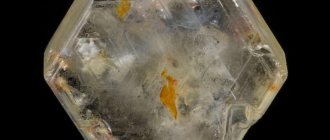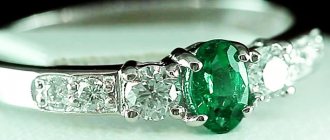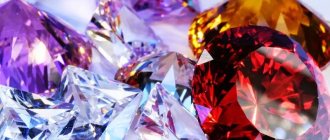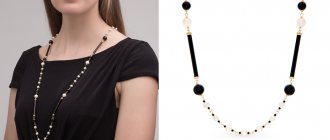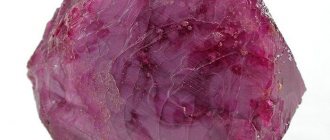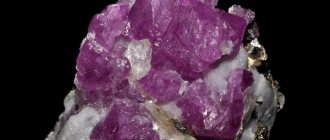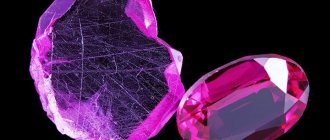| Stone type | Precious, semi-precious |
| Prevalence (Deposits) | India, Kazakhstan, Canada, Russia, USA, Thailand |
| Varieties | Leucosapphire, Padparadscha, Ruby, Sapphire, Chlorosapphire |
| Transparency | Transparent |
| Shine | Glass |
| Mohs hardness scale | 9 |
| Chemical composition | Al2O3 |
| Color | Colorless, yellow, green, red, orange, purple, pink, blue, lilac |
| Owner's color type | Not found |
| Owner's temperament | Melancholic, phlegmatic, choleric |
| Names | Not found |
| Zodiac sign | Aquarius, Cancer, Pisces |
| Date of Birth | from January 21 to February 18 from June 22 to July 22 from February 19 to March 20 |
| Chinese horoscope | Not found |
| Element | Water, Air |
| Planet | Not found |
| Day of the week | Not found |
| Month | Not found |
| Season | Not found |
| Numerology vibration | Not found |
| Chakra | Ajna, Anahata, Vishuddha, Manipura, Muladhara, Svadhisthana |
| What stones is it compatible with? | Alexandrite, Amethyst, Ruby, Sapphire |
| What stones is it not compatible with? | Not found |
| Therapeutic effect (problems) | Vision, nervous disorders, stress |
| Therapeutic effect (on organs) | Skin, gastrointestinal tract, cardiovascular system |
| Magic properties | Spiritual development, negative energy, self-confidence |
Precious stones have been used since ancient times. Rubies and sapphires could be found on the robes of the Egyptian pharaohs and on the ceremonial utensils of the Jewish high priests. These precious stones were incredibly expensive, so not everyone could afford them. At the end of the 19th century, their artificial analogues appeared. Ruby corundum, unlike ruby, was cheaper, but at the same time had the same quality characteristics.
What is ruby and sapphire corundum
Ruby and sapphire are nothing more than varieties of corundum, a hypogene group mineral. Therefore, both of these species have similar physical properties and chemical composition. The main difference is the impurities that are responsible for the color of the gemstones. For ruby it is chromium, and for sapphire it is titanium. Both minerals belong to category I precious stones, which guarantees their high price.
Sapphire and ruby corundum are synthetic stones obtained in a laboratory. This is a kind of budget alternative, with a wide range of applications: from jewelry to rocket science.
Which sapphire is better to choose: natural or synthetic
Natural stones are several times more expensive than their synthetic counterparts. This is explained by the cost of products, which includes production and sales costs. Deposits of natural minerals are drying up every year. In addition, large resources are spent on mining gems, which also increases the final cost of jewelry.
Natural stones are very expensive.
The production of synthetic corundum is cheaper. But this does not mean that the stone obtained artificially is worse. It often looks more aesthetically pleasing than the original and has brighter colors. In structure and composition it is identical to natural minerals.
How to distinguish from ruby
Natural stone corundum is a gem of natural origin. It is formed at great depths from igneous rocks. It is a mineral obtained by metamorphosing bauxite, an ore based on aluminum oxide.
The same type of ore is used in the synthesis of ruby corundum in the laboratory. The resulting product has the same crystal lattice and basic characteristics as its natural counterpart. It conveys well the shades of red and its neat shine.
The main advantage of synthetic stone is cost. It is much cheaper than natural ruby. Fraudsters often take advantage of the similarity, trying to pass off an artificial gem as a natural one. However, if you wish, you can easily distinguish a fake from the original.
- Synthetic stones change color when exposed to ultraviolet irradiation (ruby corundum begins to glow orange).
- The surface of an artificial crystal is usually covered with straight horizontal shading. In natural stone it is most often zigzag and curvilinear.
- An original can leave a scratch on the glass, a synthetic ruby cannot.
- Price is an important marker that allows you to identify the original. Artificially grown rubies are many times cheaper than natural ones.
What are the differences from sapphire
Sapphire corundum and sapphire are even more difficult to distinguish from each other than ruby and its artificial counterpart. There are several characteristics that will help identify a laboratory product.
- Hardness. Natural mineral is much harder than artificial one. You can easily verify this by simply running a stone across the glass.
- Structure. Synthetic gems are characterized by purity. But inside a natural formation you can often find minor defects: air bubbles, chips, scratches.
- Light refraction. This indicator is measured by a special device called a refractometer. A real sapphire has a value of 1.762-1.778. Any deviation indicates a fake.
- Irradiation. When exposed to UV rays, sapphire corundum turns a dirty green color, indicating the presence of a large percentage of titanium oxide.
- Asterism. “Stellarity” is found only in natural minerals.
Be sure to see: How to distinguish natural alexandrite stone from artificial
Today, scammers often sell duplex stones - a combined synthetic and natural gem. You can detect them with a magnifying glass. A thin groove will be visible in the structure of the mineral.
Corundums: rubies and sapphires. Learn more about sapphires. Part 4.
MORE DETAILS ABOUT SAPPHIRES.
As you know, the main difference between sapphire and ruby is not the color, but the chromophore, to which corundum owes its color. The main chromophores of corundum are titanium, iron and chromium. Only when the influence of chromium prevails over the influence of titanium and iron is corundum considered ruby. In all other cases, even when the color is controversial, that is, completely “ruby,” the stone will be recognized as sapphire if the above condition is met. The test for “sapphire” or “ruby” of corundum is very complex and can only be carried out in a well-equipped gemological laboratory. Sapphires from Sri Lanka
Ceylon sapphires have been known since ancient times for their excellent quality and wide range of colors. Sapphires of all known colors are found in Sri Lanka, with purple and red being the rarest. Ratnaputra is an important and highly productive mining center and newly mined stones are offered in the local market daily. Sri Lanka is famous for producing the largest sapphires in the world.
Sapphires from the Ratnaputra region are distinguished, on the one hand, by a fairly significant content of rutile “silk”, but on the other hand, by weak fractures, the most complete crystallization among all sapphires from currently known deposits, and often by the almost complete absence of significant gas and gas-liquid deposits. inclusions. Another important feature of Ceylon sapphires is that they do not have very dark tones, which is of great importance for the sapphire market as a whole. Unlike Russia, where dark-colored blue stones are most popular and valued, throughout the world these are more likely to fall into the average quality category in terms of color. Medium dark, medium and even medium light tones are much more popular and highly valued.
Ceylon sapphires with a color changing effect and sapphires with an asterism effect are also highly valued.
Both of them are extremely rare, and are often used not as precious stones for the needs of the jewelry industry, but as collectible exhibits. Madagascar sapphires
Sapphires are found in Madagascar in numerous deposits throughout the country. The southern deposits at Ilalaka are geologically linked to sapphire deposits in Sri Lanka, East Africa and Tanzania. The northern deposits of star sapphires and the northern and central ruby deposits are not geologically connected to the southern ones, and the origin of these deposits still remains a mystery. Many of the Madagascar sapphires have amazing, if not outstanding, colors! Unfortunately, Madagascar is politically very unstable. The country is very underdeveloped economically, there are practically no roads. Even on the geographical maps of Madagascar there are still a lot of dotted lines and even blank spots. About 10% of the country's territory is so inaccessible that it has not even been explored or mapped yet. In Madagascar there are practically no competent specialists capable of searching for and finding new deposits. And yet, Madagascar can certainly be called a storehouse of precious stones and minerals. And in the near future, Madagascar will, of course, become the main source of sapphires, rubies and many other varieties of precious stones on the world market.
Madagascar sapphires from southern deposits are most similar to Ceylon sapphires, although blue Madagascar sapphires have darker tones. Madagascar stones lag significantly behind their Ceylon counterparts in terms of completeness of crystallization, and because of this they significantly lose in “weight characteristics”. Due to the disproportionality of the shapes and sizes of Madagascar raw materials, large crystals weighing 10-20 grams very often have to be cut into several pieces before cutting.
The Madagascar material is generally much more included, fissured, and may have very large “windows” of gas inclusions. It was for Madagascar sapphires that methods for artificially treating cracks and cavities with lead glass were first developed. The purity requirements for Madagascar sapphires are somewhat more lenient than for Ceylon sapphires, but the monetary expression of their value is also inferior to Ceylon stones.
In terms of color, Madagascar sapphires are not inferior to Ceylon sapphires, if not superior! Madagascar is the absolute world leader in the production of colorless and pink (natural color) sapphires.
Sapphires from Kenya and Tanzania The most significant deposits in this region are the Umba Valley region in Kenya, and the Tunduru and Songea deposits in Tanzania. The deposits at Thunduru are geologically directly related to the original source rock of the supercontinent Pangea. Probably because the Tunduru region, like Ceylon, was closest to the “corundum” source. As in Ceylon, there are practically no red stones in Tunduru, although purple ones have already appeared. The Umba deposit is geologically connected with those of Madagascar. But the deposit in Songea is directly related to the deposits of the north of Madagascar. Of all the colors typical of corundums, green and red predominate in Songea. More often than in any other regions, star sapphires (Songea) and sapphires with the effect of changing light (Umbra Valley) are found in deposits in Kenya and Tanzania.
In deposits in Kenya and Tanzania (with the exception of Tunduru), classic blue sapphires are rare finds. The color palette, especially of Songea sapphires, is the richest in the world among all colored gemstones. Songhei sapphires, like rubies from this area, are distinguished by their exceptional purity of material, but at the same time by their very small size. A sapphire of 1 carat from Songea is already a rarity; one of more than 2 carats is almost a unique rarity! Sapphires from Australia Australia has quite a few small deposits of corundum that are rich enough for commercial exploitation. Probably, they also have a family connection with the supposed “single world center of corundums,” but this connection is the most distant. The vast majority of Australian corundums are very dark blue sapphires. Pure stones are much less common than in other sapphire mining areas, although in terms of size and weight, Australian sapphires can give a big head start to the rest of the world!.
Sapphires from Thailand and Cambodia.
In Thailand, commercial sapphire mining is also carried out in the Kanchaburi and Siam regions. The amount of material mined, especially in Kanchaburi, is growing from year to year, and on the world market these stones are beginning to seriously compete with those from Ceylon and Madagascar, but mainly due to price rather than quality. Thai sapphires are distinguished by good clarity, but most stones have very weakly saturated colors. Large stones, more than 1.5-2 carats, are rare. Quite a lot of very high-quality cabochon raw materials are mined in Kanchaburi.
Cambodia, gradually reviving after the horrors of the Khmer Rouge regime, is once again knocking on the world market with its sapphires. Production, which was completely stopped during the genocide, has increased significantly in recent years. Cambodian sapphires are distinguished by their purity, which is exceptional for Asian corundums, and the richness of their shades, which is rare in strength. Often both lucky factors in the value of a precious sapphire coincide in Cambodian stones!
Sapphires from other regions of the world.
First-class blue sapphires, although not in large quantities, have been found in Burma for centuries. Unfortunately, at present, due to the economic embargo, the supply of Burmese sapphires to the world market is completely absent.
Considered to be a large sapphire deposit in Montana, USA, it is currently mothballed due to commercial unprofitability. Low purity by international standards and weak color saturation do not allow sapphires from Montana to withstand competition on the world market.
Sapphires from South America come to the market sporadically, sometimes even of very high quality, but no significant deposits have yet been discovered there.
Since 2001, sapphires from Mozabique and Nigeria began to enter the world market. Mozambique sapphires are related to Tanzanian and Kenyan sapphires, and their deposit is the southern part of a large corundum-bearing zone. No large deposits have yet been discovered in Nigeria, but several significant alluvial placers have been found. The quality of Nigerian material is not the highest, but not the worst, so we can expect that Nigeria will still take its place in the corundum market.
So, as we see, nature has endowed corundums with a unique, rich color palette... But do not forget that man, thanks to his technical genius, has learned to enrich this palette very well!
The features of sapphires of various fancy colors, the difference between natural and introduced colors, and how to distinguish them will be discussed in a separate article.
History of the stone
Corundum has been known since ancient times. In Ancient Egypt, nobles and priests decorated their clothes with sapphires and rubies. Gemstones were used during religious and occult ceremonies in Ancient Persia, Mesopotamia, India and China.
In Rus', yakhont, as corundums were called, appeared much later. Rubies were called scarlet yachts, and sapphires were called azure. Green chlorosapphires were called “oriental emeralds”, and purple ones were called “amethysts of the East”.
Classification of corundum…CORUND Characteristics of the mineral.
After diamond, corundums are the hardest... Published by Sapphire.Sapphire Thursday, November 8, 2012
Corundum came to European countries from the mines of India. Sapphires and rubies quickly gained popularity and recognition, even among royalty. Many regalia, including the crown of the British Empire, are decorated with these precious minerals.
Pure rubies “the color of pigeon blood” were valued higher than diamonds and were often presented by diplomats of countries as a sign of peaceful and noble intentions.
Interesting! Most of the most famous cut rubies do not boast much weight, as jewelers specially cut them to relatively small sizes. The fact is that the smaller the red stone, the brighter and more saturated it shows its shade.
Place of Birth
The stone is mined in many countries around the world. The main deposits include:
- Russia (Kola Peninsula, Karelia, Ural, Chelyabinsk region), Krasnoyarsk Territory.
- USA.
- Norway.
- Canada.
- Greece.
- Madagascar.
- Thailand.
- Burma.
- Sri Lanka.
- India.
It is located in nests, shales, inclusions, and veins. Recent discoveries of gems include a large deposit in Kazakhstan.
Also read: Paraiba - a mineral that glows from within
Physical properties and chemical composition
The basis of both natural and synthetic corundum is aluminum oxide. Foreign impurities are responsible for the color of the stone and its variety. Pure natural corundums are usually colorless. Although they are called white, they are particularly transparent with a glassy sheen.
Titanium oxide gives the mineral a blue tint, classifying it as a type of sapphire. Chrome “gives” the stone its red color and all its variations, thus creating rubies and carbuncles. Iron oxide gives the mineral a golden hue, manganese gives it a pink or purple hue, and the combination of iron, manganese and chromium gives the green chlorosapphires, which are so often confused with emeralds. Vanadium in combination with iron in the gem gives it a brown or amber hue, somewhat reminiscent of rauchtopaz.
The hardness of natural stone is 9 points on the Moss scale. It does not dissolve in acids and melts at temperatures above 2050°C.
Artificial corundums are often subjected to ultraviolet irradiation or heating. This has almost no effect on their chemical composition, but affects the appearance, namely the shade of the stone.
Horoscope and magic
The stone has an active, strong magical influence. Blue or light blue corundum (sapphire) will help you define yourself in the profession and in society. Gives confidence, reveals talent, concentrates attention. It is worn by creative people, scientists, and students.
Red corundum (ruby) works great in love relationships and strengthens family ties. People with leadership needs should wear this gem. He will direct initiatives in the right direction and concentrate forces to achieve the goal.
Silver SOKOLOV earrings with corundum and cubic zirconia (go to the SUNLIGHT catalog)
The stone respects and promotes active people, those who are not afraid of difficulties and solving complex problems. His energy works in unison with such a personality, multiplying the abilities and strength of the owner. Helps you go the right way without wasting yourself on empty ideas.
As for the compatibility of the crystal with representatives of the zodiac signs, there is a division according to color and specific type of mineral. Ruby corundum makes excellent friends with Capricorn, Leo and Scorpio. The strong and powerful energy of people born under these signs completely coincides with the powerful impulses of the stone. An amulet or talisman with a gem will help you achieve high results, no matter what the task.
Blue corundum (sapphire) is more suitable for Aquarius, Taurus, and Sagittarius. Representatives of these signs mainly gravitate toward creative pursuits. Sapphire will provide an opportunity to reveal talent, give confidence in a difficult situation, and strengthen self-esteem.
Silver SOKOLOV earrings with corundum and cubic zirconia (go to the SUNLIGHT catalog)
Precious gems look gorgeous in jewelry. They are always desirable for every woman. Corundum will not harm those who passionately adore it. Therefore, everyone can wear jewelry with crystals. As a last resort, if there is some incompatibility with the stone, then it will simply be neutral. That is, you shouldn’t expect help from him, but he won’t turn into an evil enemy either.
How to distinguish natural from fake
Stones of artificial origin cannot always be distinguished from natural ones. If possible, you should use special equipment: a microscope or a magnifying glass. You can even ask a specialist for help - a professional jeweler.
Using a magnifying glass, the structure of the stone is studied. The presence of bubbles and minor defects indicates its natural nature. If the seller allows, you can heat the stone and evaluate the range of changes in its color. Genuine rubies and sapphires do not change shade. In addition, they are harder than synthetic analogues or artificially created duplexes. This can be checked by simply running the gem across the glass.
The presence of certificates confirming the natural origin of the stone is also of great importance. In addition to the basic physical characteristics, the documents must indicate the mineral deposit.
Are you fascinated by ruby corundum jewelry?
VeryNo
What types of natural corundum exist?
Many people can answer the question about corundum about what it is, but not everyone knows what types of this mineral exist in nature.
Experts identify the following types of stones of natural origin:
- Sapphire (can be green, blue and purple);
- Padparadscha (yellow or orange mineral);
- Ruby (red shade);
- Common corundum (gray);
- Leucosapphire (colorless gem);
- Star ruby (mineral with asterism effect).
Many people want to become the owner of ruby or sapphire jewelry. But, the price for them is quite high, especially for rubies. Products with synthetic corundum will come to the rescue. Thanks to the creation of artificial stones, most beautiful ladies were able to become owners of luxurious jewelry.
All artificially created gems are divided into two large groups. Experts distinguish those stones that are made by analogy with natural ones and those minerals that are completely new crystals.
Gems obtained in laboratories are produced according to ready-made patterns; they are all similar to each other. Natural stones develop the way they want, no one interferes with this process, each of them is individual.
Defects in artificial gems are extremely rare; flaws that can be found in natural stones sometimes give them a special uniqueness.
Healing properties
Natural stones have long been credited with healing properties. It is believed that corundums can have a beneficial effect on the following systems of the human body:
- cardiovascular;
- digestive;
- urinary;
- circulatory;
- endocrine.
Blue sapphire is good for the eyes, according to traditional healers, as it normalizes intraocular pressure. Yellow varieties improve metabolism and have a rejuvenating effect. Therefore, stones of a golden-sunny hue are often presented as gifts to women.
Be sure to check out: Who can give pearls and when?
Therapeutic effect
Healers consider the healing properties of a stone to be equally effective in a pocket, jewelry or on a cord.
The nature of the effect is determined by the color of the mineral:
- Violet. Calms nerves, anxiety, and drives away depression. Useful for people with mood swings. It is recommended to wear it for traumatic brain injuries, vascular diseases, and neuralgia.
- Red. Normalizes metabolism and hormonal levels, improves blood quality, heals the heart and blood vessels. Activates the endocrine system.
- Blue. Has the ability to preserve and restore eye health.
- Green. Improves digestion, protects against colds or eases their course.
- Orange, yellow. They create a rejuvenating effect, restore metabolic processes, and improve the functioning of the gastrointestinal tract.
Decoration with natural stones of different colors has a complex effect, but not as strong as a single crystal.
Magical meaning
Sapphires and rubies have been used in occult rituals since ancient times, so it has always been endowed with magical properties. According to esotericists, corundum is capable of exerting a powerful influence on the course of thoughts and actions of its owner. This is a stone of active and purposeful individuals, people with ambitions and high expectations.
Corundum will help you concentrate on the path to your goal. The stone actively supports the owner, driving away fears and increasing self-confidence. However, at the same time, it requires energy and active action from the owner. The gem is not suitable for lazy and mediocre people.
Blue sapphire is often given to people whose work involves mental activity. It is a stone of scientists and researchers. A real natural ruby can protect against negative energy and support in times of crisis. Earrings with this stone will help you find harmony, both with yourself and with the world around you, and a ring will allow you to reveal your hidden potential.
Wearing recommendations
Since not everyone can afford to purchase natural corundum, many prefer more affordable jewelry, for example, earrings where laboratory sapphire is set in silver or gold. The artificial analogue is much cheaper, which is why it is in great demand.
Most esotericists claim that an artificial gem has magical properties similar to natural ones. It has the same powerful cosmic energy and transmits it to man. Therefore, when wearing a stone, it is important to consider some nuances:
- do not wear sapphire jewelry when you are in a bad mood;
- you should not surround the mineral with negative energy, for example, quarrels;
- in case of disastrous events, it is better to hide the corundum;
- sapphire cannot be used in spiritualistic seances - it is capable of enclosing a spirit;
- do not wear someone else's sapphire;
- do not give your talisman to a stranger.
To enhance its properties, it is necessary for the mineral to get used to the owner, so you need to talk to him as often as possible and tell your secrets and desires. Only strong faith in the talisman gives it magical properties.
Who is it suitable for?
Corundum is not suitable for everyone. When choosing jewelry with any type of this mineral, you need to take into account both external data and zodiac affiliation.
By zodiac sign and date of birth
The influence of corundum on its owner is closely related to his zodiac sign.
| Zodiac sign | Type of corundum (color) | Influence |
| Aries | Sapphire blue and yellow | Aries should wear corundum only after 40 years. In this case, they will work as amulets, providing, among other things, a rejuvenating effect |
| Taurus | Blue and cyan sapphire | A Taurus talisman with a stone will protect you from illness, allow you to develop intuition and realize hidden talents. The mineral has a good effect on memory |
| Twins | Dark blue, purple sapphire | Geminis wearing the stone will have improved leadership qualities. Sapphire will not allow the owner to quit halfway |
| Cancer | Any shade of sapphire and ruby | The stone as a talisman will reveal your potential and bestow extraordinary luck. Corundums make Cancers more positive and open |
| a lion | Contraindicated | Wearing a stone can lead to aggravation of relationships with loved ones, conflicts with loved ones |
| Virgo | Green and blue sapphire | Corundum will give a skeptical Virgo positivity and encourage dramatic changes in life. |
| Scales | Purple sapphire, red ruby | The combination of Libra and corundum is the key to success. Representatives of this sign, equipped with a talisman, will experience success in any endeavor |
| Scorpion | Red and pink ruby | For closed Scorpios, the gem will help them make friends and improve relationships. Red ruby ignites passion |
| Sagittarius | Black blue sapphire | The stone teaches sharp Sagittarius delicacy and diplomacy, brings idyll and peace to the house |
| Capricorn | Contraindicated | The gem enhances phobias and negative character traits |
| Aquarius | Transparent corundums | The stone will help this sign find its life path and attract good luck. |
| Fish | White corundums | For altruistic Pisces, the mineral will help replenish energy reserves and ward off melancholy |
If we talk about dates of birth and their connection with the zodiac, then corundum is a talisman for those born on the following days:
- Aries – March 22, 28;
- Taurus – April 26;
- Gemini – May 21, 27;
- Cancer – June 21;
- Leo – July 25, 25;
- Virgo – September 6, 17;
- Libra – October 19;
- Scorpio – October 25, November 8;
- Sagittarius – December 14, November 29;
- Capricorn – January 2, 8;
- Aquarius – January 29, February 6, 17;
- Pisces – February 21, March 7.
Knowing the talisman stones by date of birth, you can choose a successful and useful gift.
By color type
Color type is a person’s natural palette, characterized by the color of hair, skin and eyes. There are 4 main types of appearance in nature, which are correlated with the seasons.
| Color type | Characteristic | Stone |
| Summer | Blonde hair, translucent pink skin, gray, green and blue eyes | Blue sapphire |
| Autumn | Dark brown, brown and red hair, slightly dark skin, brown and green eyes | Chlorosapphires, red rubies |
| Winter | Dark hair, white “porcelain” skin, blue, green and gray eyes | Ceylon dark red rubies, black and blue sapphires |
| Spring | Light blond, wheat-colored hair, brown and green eyes. Peach skin tone | Yellow, pink sapphires, padparadscha rubies |
The table presented will help you choose the most successful option for decorating with a stone.
Photos of minerals and products made from them
Frames for rings, pendants, and bracelets made from elite varieties of corundum are made from platinum, gold, and silver. The precious mineral is processed using the cabachon method.
Jewelry with inserts of blue and green sapphire and red ruby look exquisite and emphasize the status of the owner.
By the way! Jewelry made from transparent crystals in rich colors looks no less impressive than diamonds.
Deposits: where there are formations of natural mineral
The most famous deposits are located in a place called the “Asian quadrangle”. It includes Myanmar, Thailand, Sri Lanka and India.
The purest rubies are mined in Burma. Rare chlorospaphyres and black-blue stones are found in deposits in Australia and Tanzania.
In Russia, mining is carried out in the Urals, Primorye and Krasnoyarsk Territory, and one of the most recently discovered deposits is mines in Kazakhstan. Precious corundum is also mined in the USA, Canada, Norway and Greece.
Interesting! According to geological data, the world's sapphire reserves are 20 times higher than ruby reserves.
Methods for producing artificial crystals
Nanosapphires are synthesized on an industrial scale around the world. In addition to the Verneuil method, other technologies are also used.
The Kyropoulos method is based on growing corundum from molten aluminum oxide. The seed crystal is immersed in a liquid medium, where its growth begins with the help of heating. It is gradually pulled out of the melt, continuously rotating around its axis.
Synthetic sapphires are synthesized all over the world.
Other methods for producing sapphires from melt (Czochralski, Stepanov) are based on moving a crystal or container in a temperature gradient field. With this method, the temperature values of the melt are equal to or slightly higher than the melting point. The lower part of the seed crystal is constantly in contact with the melt. The crystal grows down around the seed and is pulled out into a monolithic cylinder.
Application
In addition to the jewelry industry, corundum derivatives are actively used in a variety of industries. In optics and instrumentation, sapphire glass is used to increase the strength of lenses. In the aircraft industry, windows are equipped with this part.
In mechanical engineering and machine tools, corundum with a high iron content is used as an abrasive material. Artificial sapphires are needed for the production of medical instruments, luxury watches, mobile gadgets and digital equipment.
In construction, corundum is used as a component of the thermal insulation layer.
Where is the gem used?
The mineral is widely used in the abrasive industry. Granular opaque crystals are used to make abrasive and grinding tools, polishing powders. Due to its high heat resistance, it is used as a heat-insulating material in the radio-electronic field and in medical production.
The unsurpassed strength of corundum and the property of its transparency have found application in aircraft construction. Airplane and even spaceship windows are made from this material. A high-quality glass substitute is called “sapphire glass.”
But the most widespread use of the gemstone is in jewelry. Craftsmen love to work with this gem. Jewelry with ruby and sapphire inserts fascinates and enchants. A bracelet, pendant, earrings or ring with corundum is a valuable and desirable gift.
Price
The price of a stone depends on a number of its parameters, such as:
- purity;
- weight;
- shade;
- cut.
Category I rubies can cost up to $1,500 per carat. But the cost of the same stones, but category III, will be significantly different and will not exceed $400-500 per unit of weight.
The most expensive rubies are those from Burma. They are sold exclusively at auctions, where the price per carat starts at $3,000.
Sapphires are cheaper, somewhere around $150 per carat. However, the larger the stone, the higher the price per unit weight. Minerals larger than 8-9 carats cost at least 10 thousand dollars on the market.
Talismans and amulets
A talisman with corundum will give its owner protection from the negative influence of others. If you wear a stone on your chest, it will help protect you from negative emotions and unreasonable fears. Earrings with a stone will give a person prudence and insight. Wearing a ring with a sapphire or ruby helps to reveal talents.
It is useful to carry a natural untreated stone with you, which is recommended to be protected from the eyes of others.
Corundums will enhance their energy if worn together with amethysts and garnets.
Main conclusions
Ruby corundum is an artificial analogue of natural stone with an identical crystal lattice structure and a similar chemical composition.
- Like ruby, sapphire corundum is a laboratory-grown mineral.
- You can distinguish artificial analogues from the original by visually examining the structure, heating or irradiating the stone.
- The color of corundum is closely related to its composition, namely to the impurities that are contained in small quantities in the ore.
- The areas of application of the stone include both jewelry and industrial sectors.
- If you wish, you can choose a stone based on your zodiac sign and birth period.
Corundum can be an excellent talisman if you choose the right variety and don’t forget to care for it regularly.
Share your opinion about this amazing mineral and stories about your talismans and amulets with precious and semi-precious stones.
Rules for caring for corundums
Caring for durable stones is easy:
- jewelry is regularly wiped with a damp cloth;
- clean with a weak solution of ammonia (10–15 drops per glass of water) or mild washing powder (a teaspoon per glass);
- stored in a box with other jewelry.
You need to make sure that the insert stone sits firmly in the frame and does not fall out. It is undesirable to heat it too much: it will fade.
Pendant
Caring for synthetic corundum is even simpler: temperatures, sun, and household chemicals do not matter.
